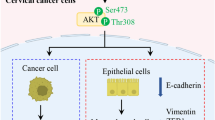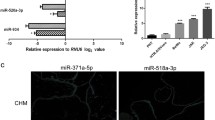Abstract
Purpose
Choriocarcinoma (CC) is a rare and highly malignant epithelial tumour. However, the mechanism underlying its occurrence and development remains unknown. We aimed to reveal the biological significance and prognostic value of Claudin-6 (CLDN6) in gestational trophoblastic disease (GTD).
Patients and methods
We collected clinical GTD specimens from 2011 to 2019 and measured CLDN6 gene expression by immunohistochemistry (IHC). High-throughput mRNA sequencing (RNA-seq) revealed a GTD progression-associated gene. CCK-8, wound healing, and flow cytometry assays were used to assess the biological effects of CLDN6 overexpression and knockdown. The medical records of 118 GTD patients from 2011 to 2019 were retrospectively analysed to identify correlations between CLDN6 expression and GTD patient clinical–pathological parameters; these correlations were analysed using the chi-square test and one-way ANOVA. Univariate logistic regression was used to analyse various prognostic parameters of patients with post-molar GTN.
Results
CLDN6 had the second highest fold change in gene expression between GTN and normal samples. CLDN6 was highly expressed in GTN tissues and CC cell lines, and silencing CLDN6 inhibited the proliferation and migration and promoted the apoptosis of CC cells. CLDN6 overexpression was significantly correlated with uterine size (p = 0.01) and ovarian cysts > 6 cm (p = 0.027), CLDN6 expression was significantly higher in HR-GTNs than in low-risk GTNs (LR-GTNs) (p = 0.008), and logistic regression analysis showed that CLDN6 expression in hydatidiform moles (HMs) was related to a high risk of developing post-molar GTN (OR = 2.393, p = 0.03).
Conclusion
We propose that CLDN6 participates in the development of GTD and may become a new therapeutic target for CC.



Similar content being viewed by others
Data availability
All the data in our study will be made available by the authors upon reasonable request (addressed to Yifeng Wang).
Abbreviations
- CC:
-
Choriocarcinoma
- HR-GTN:
-
High-risk gestational trophoblastic neoplasm
- CLDN6:
-
Claudin-6
- GTD:
-
Gestational trophoblastic disease
- IHC:
-
Immunohistochemistry
- RNA-seq:
-
RNA sequencing
- LR-GTNs:
-
Low-risk GTNs
- DEGs:
-
Differentially expressed genes
- rHMs:
-
Hydatidiform moles that regressed
- FIGO:
-
International Federation of Obstetrics and Gynecology
- cHMs:
-
Complete HMs
- STR:
-
Short tandem repeat
- MEM:
-
Minimum essential medium
- RPMI:
-
Roswell Park Memorial Institute
- IRS:
-
Immunoreactive score
- IC50:
-
Half-maximal inhibitory concentration values
- GO:
-
Gene ontology
- shCLDN6/CLDN6-OV:
-
CLDN6 overexpression or downregulation
References
Jiang F, Wan XR, Xu T, Feng FZ, Ren T, Yang JJ, et al. Evaluation and suggestions for improving the FIGO 2000 staging criteria for gestational trophoblastic neoplasia: a ten-year review of 1420 patients. Gynecologic Oncol. 2018;149(3):539–44. https://doi.org/10.1016/j.ygyno.2018.04.001.
Zohoun AG, Hounmenou K, Mechtani Sel I, Razine R, Dami A, Filali A, et al. Intérêt du dosage de l’hormone chorionique gonadotrope dans les maladies trophoblastiques gestationnelles [Utility of hCG dosage in the management of gestational trophoblastic diseases]. Annales de Biologie Clinique. 2013;71(6):639–43. https://doi.org/10.1684/abc.2013.0908.
Nadhan R, Vaman JV, Nirmala C, Sengodan SK, Hemalatha S, Rajan A, et al. Insights into dovetailing GTD and cancers. Critical Rev Oncol/Hematol. 2017;114:77–90. https://doi.org/10.1016/j.critrevonc.2017.04.001.
Stenman U, Tiitinen A, Alfthan H, Valmu LJ. The classification, functions and clinical use of different isoforms of HCG. HRU. 2006;12(6):769–84. https://doi.org/10.1093/humupd/dml029.
Stenman U, Alfthan H, Hotakainen KJ. Human chorionic gonadotropin in cancer. CB. 2004;37(7):549–61. https://doi.org/10.1016/j.clinbiochem.2004.05.008.
Wu Q, Liu Y, Ren Y, Xu X, Yu L, Li Y, et al. Tight junction protein, claudin-6, downregulates the malignant phenotype of breast carcinoma. Eur J Cancer Prev. 2010;19(3):186–94. https://doi.org/10.1097/CEJ.0b013e328337210e.
Krause G, Winkler L, Mueller S, Haseloff R, Piontek J, Blasig IJ, et al. Structure and function of claudins. BEBA. 2008;1778(3):631–45. https://doi.org/10.1016/j.bbamem.2007.10.018.
Oliveira S, Morgado-Díaz JJC. Claudins: multifunctional players in epithelial tight junctions and their role in cancer. CMLS. 2007;64(1):17–28. https://doi.org/10.1007/s00018-006-6314-1.
Sullivan LM, Yankovich T, Le P, Martinez D, Santi M, Biegel JA, et al. Claudin-6 is a nonspecific marker for malignant rhabdoid and other pediatric tumors. Am J Surg Pathol. 2012;36(1):73–80. https://doi.org/10.1097/PAS.0b013e31822cfa7e.
Ushiku T, Shinozaki-Ushiku A, Maeda D, Morita S, Fukayama M. Distinct expression pattern of claudin-6, a primitive phenotypic tight junction molecule, in germ cell tumours and visceral carcinomas. Histopathology. 2012;61(6):1043–56. https://doi.org/10.1111/j.1365-2559.2012.04314.x.
Turksen K, Troy T-C. Claudin-6: a novel tight junction molecule is developmentally regulated in mouse embryonic epithelium. Dev Dyn. 2001;222(2):292–300. https://doi.org/10.1002/dvdy.1174.
Hui P. Gestational trophoblastic tumors: a timely review of diagnostic pathology. Arch Pathol Lab Med. 2019;143(1):65–74. https://doi.org/10.5858/arpa.2018-0234-RA.
Vilotic A, Bojic-Trbojevic Z, Vicovac L, Jovanovic KM. Macrophage migration inhibitory factor is differentially expressed in normal and choriocarcinoma trophoblast cells. Neoplasma. 2020;67(2):323–32. https://doi.org/10.4149/neo_2020_190321N255.
Kingdon S, Coleman R, Ellis L, Hancock B. Deaths from gestational trophoblastic neoplasia: any lessons to be learned? JORM. 2012;57:293–6.
Neubauer N, Strohl A, Schink J, Lurain J. Fatal gestational trophoblastic neoplasia: an analysis of treatment failures at the brewer trophoblastic disease center from 1979–2012 compared to 1962–1978. GO. 2015;138(2):339–42. https://doi.org/10.1016/j.ygyno.2015.05.041.
Ottevanger PJ. Ovarian cancer stem cells more questions than answers. SICB. 2017;44:67–71. https://doi.org/10.1016/j.semcancer.2017.04.009.
Batlle E, Clevers H. Cancer stem cells revisited. NM. 2017;23(10):1124–34. https://doi.org/10.1038/nm.4409.
Ohkubo T, Ozawa MJ. The transcription factor Snail downregulates the tight junction components independently of E-cadherin downregulation. JOCS. 2004;117:1675–85. https://doi.org/10.1242/jcs.01004.
Aiello N, Stanger B. Echoes of the embryo: using the developmental biology toolkit to study cancer. JDM Mech. 2016;9(2):105–14. https://doi.org/10.1242/dmm.023184.
Anderson WJ, Zhou Q, Alcalde V, Kaneko OF, Blank LJ, Sherwood RI, et al. Genetic targeting of the endoderm with claudin-6CreER. Dev Dyn. 2008;237(2):504–12. https://doi.org/10.1002/dvdy.21437.
Lu Y, Dang Q, Bo Y, Su X, Wang L, Sun J, et al. The expression of CLDN6 in hepatocellular carcinoma tissue and the effects of CLDN6 on biological phenotypes of hepatocellular carcinoma cells. J Cancer. 2021;12(18):5454–63. https://doi.org/10.7150/jca.55727.
Kojima M, Sugimoto K, Kobayashi M, Ichikawa-Tomikawa N, Kashiwagi K, Watanabe T, et al. Aberrant Claudin-6-adhesion signaling promotes endometrial cancer progression via estrogen receptor α. Mol Cancer Res. 2021;19(7):1208–20. https://doi.org/10.1158/1541-7786.MCR-20-0835.
Yu S, Zhang Y, Li Q, Zhang Z, Zhao G, Xu J, et al. CLDN6 promotes tumor progression through the YAP1-snail1 axis in gastric cancer. Cell Death Dis. 2019;10(12):949. https://doi.org/10.1038/s41419-019-2168-y.
Kong FE, Li GM, Tang YQ, Xi SY, Loong JHC, Li MM, et al. Targeting tumor lineage plasticity in hepatocellular carcinoma using an anti-CLDN6 antibody-drug conjugate. Sci Transl Med. 2021. https://doi.org/10.1126/scitranslmed.abb6282.
Song P, Li Y, Dong Y, Liang Y, Qu H, Qi D, et al. Estrogen receptor β inhibits breast cancer cells migration and invasion through CLDN6-mediated autophagy. J Exp Clin Cancer Res. 2019;38(1):354. https://doi.org/10.1186/s13046-019-1359-9.
Huang L, Zhao C, Sun K, Yang D, Yan L, Luo D, et al. Downregulation of CLDN6 inhibits cell proliferation, migration, and invasion via regulating EGFR/AKT/mTOR signalling pathway in hepatocellular carcinoma. Cell Biochem Function. 2020;38(5):541–8. https://doi.org/10.1002/cbf.3489.
Funding
This study was funded by the Natural Science Foundation of Fujian Province (2021j01409), Science and Technology Project of Health Commission of Fujian Province (2021CX0101) and Joint Funds for the Innovation of Science and Technology, Fujian province (2020y9155).
Author information
Authors and Affiliations
Contributions
Conceptualization: QW, YW; Methodology: MP, TL, LC; Formal analysis and investigation: MP, CL, XM, Writing–original draft preparation: MP; Writing–review and editing: QW; Funding acquisition: QW; Resources: PS, YW; Supervision: PS, YW.
Corresponding authors
Ethics declarations
Conflict of interest
The authors declare that they have no conflict of interest.
Ethical approval
This study was performed in line with the principles of the Declaration of Helsinki. Approval was granted by the Ethics Committee of the College of Clinical Medicine for Obstetrics & Gynecology and Pediatrics, Fujian Medical University (FMCH2021KRD020).
Informed consent
Informed consent was obtained from all the patients.
Additional information
Publisher's Note
Springer Nature remains neutral with regard to jurisdictional claims in published maps and institutional affiliations.
Rights and permissions
Springer Nature or its licensor (e.g. a society or other partner) holds exclusive rights to this article under a publishing agreement with the author(s) or other rightsholder(s); author self-archiving of the accepted manuscript version of this article is solely governed by the terms of such publishing agreement and applicable law.
About this article
Cite this article
Wu, Q., Peng, M., Lv, C. et al. Claudin-6 enhances the malignant progression of gestational trophoblastic neoplasm by promoting proliferation and metastasis. Clin Transl Oncol 25, 1114–1123 (2023). https://doi.org/10.1007/s12094-022-03021-4
Received:
Accepted:
Published:
Issue Date:
DOI: https://doi.org/10.1007/s12094-022-03021-4




